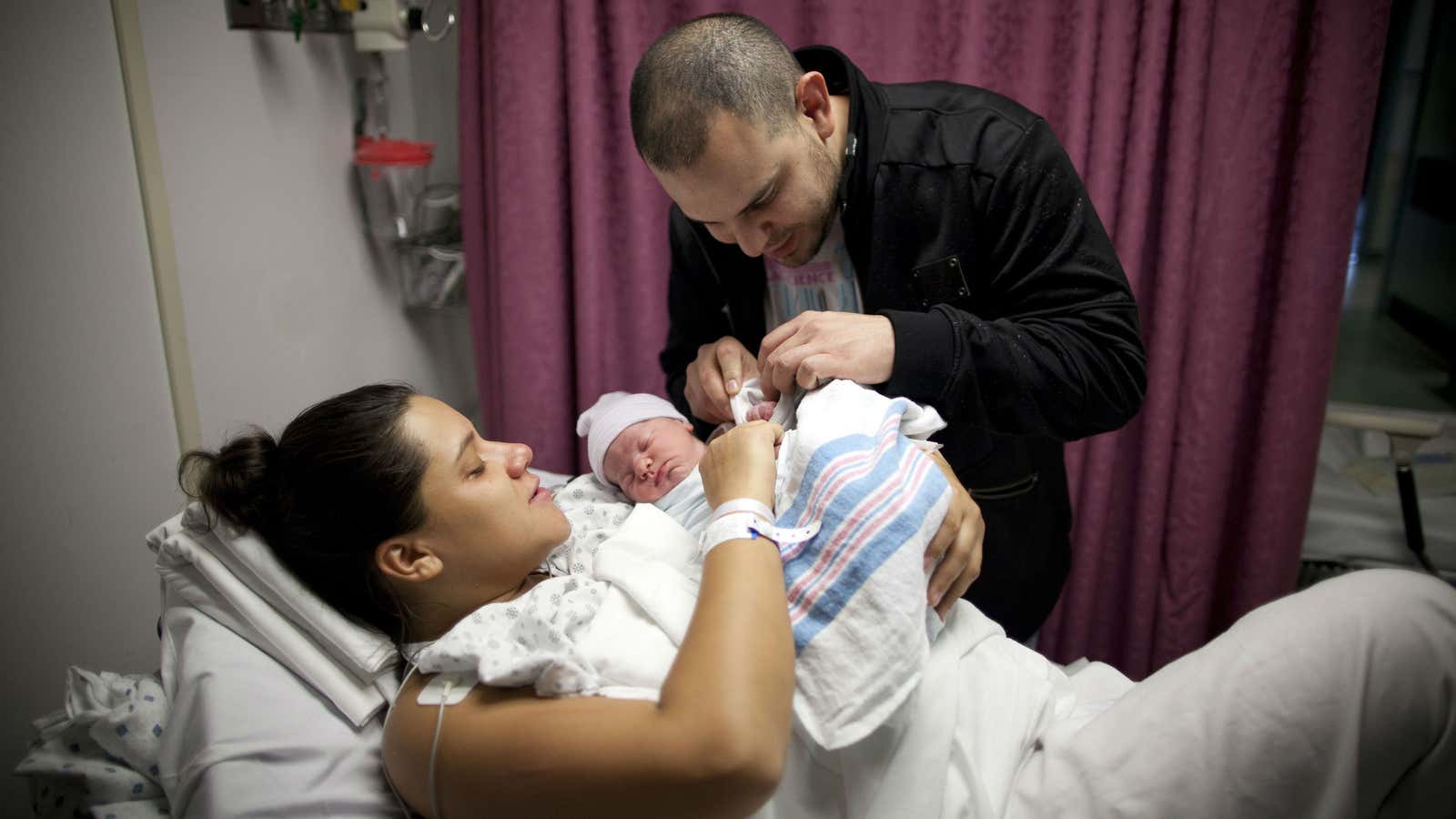The morning after my second daughter was born I took her picture—she was beautiful, serene—and posted it on Facebook. There was much my Facebook friends could surmise from the photo, and much that marketers could mine: her date of birth and her eye color and her name, for instance. But what they knew for certain was that she had been born at the hospital.
The dead giveaway? The blanket.
You’ve seen the one, whether you’ve had a baby or not: it is mostly white, with thick blue and thinner pink stripes at the edges. If you’re on Facebook or Instagram, you’ve seen it tens, maybe hundreds of times.
The blanket is part of the Kuddle-Up line made by a Mundelein, Illinois-based healthcare supply company called Medline. The company was started in 1910 by A.L. Mills, an Arkansan who moved to Illinois and made his living creating butcher aprons for Chicago’s meat-packing industry. Eventually that led to work making surgical gowns—he was the first to shift them from light-reflecting white to the now ubiquitous light-absorbing jade green style. He did the same for hospital gowns: made them patterned instead of solid drab shades and switched the tie from the back to the side, for what Jim Abrams, Medline’s chief operating officer, called “a little more modesty.”
In the early 1950s, receiving blankets were usually made from dull beige cloth. Mills, ever the innovator, wanted to do for blankets what he had done for scrubs. “He asked the women in the office what they would do differently to spice it up a little bit,” says Abrams. They went through a number of iterations and finally settled on the blue- and pink-striped version because, as you might have suspected, it’s good for both girls and boys. The pattern is strangely appealing—before I knew that 99% of newborns are wrapped in identical blankets, I thought it was handsome. It never appears dated or cutesy or Disney. It is truly a classic.
Clearly, many people agree. Sixty years later, Medline sells 1.5 million Kuddle-Up blankets in Candy Stripe every year (the other patterns, with elephants or ducks, are less pervasive). At the HealthAlliance Hospital in Kingston, NY, for instance, the housekeeping staff buys 3,100 100% cotton blankets a year, and often uses four to five of them for each newborn.
While the success of the blanket may have something to do with aesthetics, it has more to do with timing. In 1950, 88% of all births were in hospitals (the figure is now 99%). Just 10 years earlier, only 56% of births took place there; the rest were mostly at home or in birthing centers.
Childbirth had largely been domestic work in the 19th century. With the advent of pain medication, the rise of comprehensive health insurance in the 1910s (later, of course, defeated) and the establishment of the American Board of Obstetricians and Gynecology in 1930, among other factors, childbirth moved from the bedroom to the hospital room.
The Kuddle-Up blanket was entwined with the institutionalization of childbirth. Just as we began to standardize the process of birth, we began to standardize the post-partum experience, too, such that the newborn photo in the Kuddle-Up blanket is, at this point, an instant signifier. Thousands of new parents, and even grandparents, were themselves swaddled in such a blanket when they were born; that same pattern spans generations. “All of my kids, my friends’ kids—everybody has swaddled their children in that blanket,” says Abrams. Yet few of us would know that were it not for the posting of newborn photos on social media.
Not only does almost every hospital-born child in the US get wrapped in the Kuddle-Up, most of them have their photos pasted on the web very soon after. (Editor’s update: Kaiser Permanente, the hospital chain and managed-care company, has its own line of blankets, including one featuring baby animals.) A 2011 study found that 66% of GenX parents (those born in the late ’60s and ’70s) post photos of their children online. In the UK, one study found, most parents post a picture of their newborn within an hour of his birth. While no one at Facebook could say how many newborn photos are posted, its users upload 350 million pictures each day.
Perhaps most surprising, is that the blankets are sold all over the world, and made in Karachi, Pakistan. Medline won’t say exactly when or why they moved their operations there.
Just as we have exported the medicalized American model of childbirth—according to Childbirth Across Cultures (which my mother, who gave birth to me in a freestanding birth center, edited), some Chinese hospitals have a C-section rate of 90%, which are known as “status births”—so have we exported the blanket that goes with it. Now Kuddle-Up not just a national signifier, but a global one, though the blankets are not nearly as ubiquitous overseas and in the developing world, and neither is access to Facebook.
Its mass production, its proliferation, have done nothing to curb our affinity for or attachment to the blanket. Many parents save their child’s Kuddle-Up (technically they’re not supposed to be taken from the hospital, but hundreds of them go home with the babies each year), despite the fact that it’s identical to 1.5 million other blankets sold that year and that it may have been used on as many as several newborn children. It doesn’t matter how common the fabric—the experience to which it’s attached is unique.
Admittedly, I didn’t keep my daughter’s Kuddle-Up blanket—space concerns trumped sentimentality. But I loved putting her picture on Facebook—privacy concerns aside—wrapped in what I now know is the world’s most common receiving blanket. It didn’t matter to me that elsewhere on the planet, and in many pages on Facebook, 1.5 million other people were doing the same.
